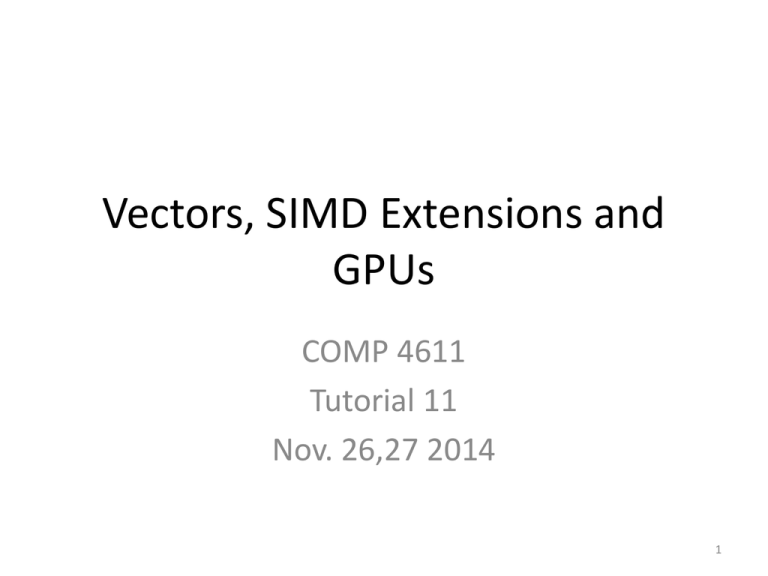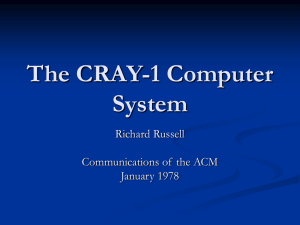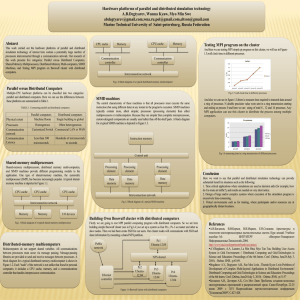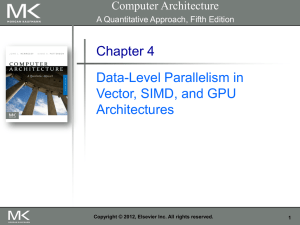
Vectors, SIMD Extensions and
GPUs
COMP 4611
Tutorial 11
Nov. 26,27 2014
1
Introduction
SIMD Introduction
• SIMD(Single Instruction Multiple Data)
architectures can exploit significant datalevel parallelism for :
– Matrix-oriented scientific computing
– Media-oriented image and sound processors
• SIMD has easier hardware design and
working flow compared with MIMD(Multiple
Instruction Multiple Data)
– Only needs to fetch one instruction per data
operation
• SIMD allows programmer to continue to
think sequentially
2
Introduction
SIMD Parallelism
• Vector architectures
• SIMD extensions
• Graphics Processing Units (GPUs)
3
Vector Architectures
Vector Architectures
• Basic idea:
– Read sets of data elements into “vector registers”
– Operate on those registers
• A single instruction -> dozens of operations on
independent data elements
– Disperse the results back into memory
• Registers are controlled by compiler
– Used to hide memory latency
4
Vector Architectures
VMIPS
Example architecture: VMIPS
– Loosely based on Cray-1
– Vector registers
• Each register holds a 64-element, 64 bits/element vector
• Register file has 16 read ports and 8 write ports
– Vector functional units
• Fully pipelined
• Data and control hazards are detected
– Vector load-store unit
• Fully pipelined
• One word per clock cycle after initial latency
– Scalar registers
• 32 general-purpose registers
• 32 floating-point registers
5
The basic structure of a vector architecture, VMIPS.
This processor has a scalar architecture just like MIPS. There are also eight
64-element vector registers, and all the functional units are vector functional
units.
6
Vector Architectures
VMIPS Instructions
• ADDVV.D: add two vectors
• MULVS.D: multiply each element of a vector by a scalar
• LV/SV: vector load and vector store from address
• Example: DAXPY
– Y = a x X + Y, X and Y are vectors, a is a scalar
L.D
LV
MULVS.D
LV
ADDVV
SV
F0,a
V1,Rx
V2,V1,F0
V3,Ry
V4,V2,V3
Ry,V4
; load scalar a
; load vector X
; vector-scalar multiply
; load vector Y
; add
; store the result
• Requires 6 instructions
7
Vector Architectures
DAXPY in MIPS Instructions
Example: DAXPY (double precision a*X+Y)
Loop:
L.D
F0,a
DADDIU R4,Rx,#512
L.D
F2,0(Rx )
MUL.D
F2,F2,F0
L.D
F4,0(Ry)
ADD.D
F4,F2,F2
S.D
F4,9(Ry)
DADDIU Rx,Rx,#8
DADDIU Ry,Ry,#8
SUBBU
R20,R4,Rx
BNEZ
R20,Loop
; load scalar a
; last address to load
; load X[i]
; a x X[i]
; load Y[i]
; a x X[i] + Y[i]
; store into Y[i]
; increment index to X
; increment index to Y
; compute bound
; check if done
• Requires almost 600 MIPS instructions
Copyright © 2012, Elsevier Inc. All rights reserved.
8
SIMD Instruction Set Extensions for Multimedia
SIMD Extensions
• Media applications operate on data types narrower
than the native word size
– Example: “partition” 64-bit adder --> eight 8-bit
elements
• Limitations, compared to vector instructions:
– Number of data operands encoded into op code
– No sophisticated addressing modes
– No mask registers
9
Example SIMD Code
Example DAXPY:
Loop:
L.D
F0,a
MOV
F1, F0
MOV
F2, F0
MOV
F3, F0
DADDIU R4,Rx,#512
L.4D F4,0[Rx]
MUL.4D F4,F4,F0
L.4D
F8,0[Ry]
ADD.4D F8,F8,F4
S.4D
F8,0[Ry]
DADDIU Rx,Rx,#32
DADDIU Ry,Ry,#32
DSUBU R20,R4,Rx
BNEZ R20,Loop
;load scalar a
;copy a into F1 for SIMD MUL
;copy a into F2 for SIMD MUL
;copy a into F3 for SIMD MUL
;last address to load
;load X[i], X[i+1], X[i+2], X[i+3]
;a*X[i],a*X[i+1],a*X[i+2],a*X[i+3]
;load Y[i], Y[i+1], Y[i+2], Y[i+3]
;a*X[i]+Y[i], ..., a*X[i+3]+Y[i+3]
;store into Y[i], Y[i+1], Y[i+2], Y[i+3]
;increment index to X
;increment index to Y
;compute bound
;check if done
10
SIMD Instruction Set Extensions for Multimedia
SIMD Implementations
Implementations:
– Intel MMX (1996)
• Eight 8-bit integer ops or four 16-bit integer ops
– Streaming SIMD Extensions (SSE) (1999)
• Eight 16-bit integer ops
• Four 32-bit integer/fp ops or two 64-bit integer/fp ops
– Advanced Vector Extensions (2010)
• Four 64-bit integer/fp ops
11
Graphics Processing Units
Graphics Processing Units
Given the hardware invested to do
graphics well,
how can we supplement it to
improve performance of a
wider range of applications?
12
• NVIDIA GPU
– Reliable performance, communication
between CPU and GPU using the PCIE channels
– Tesla K40
• 2880 CUDA cores
• 4.29 T(Tera)FLOPs (single precision)
– TFLOPs: Trillion Floating-point operations per second
• 1.43 TFLOPs (double precision)
• 12GB memory with 288GB/sec bandwidth
13
Graphics Processing Units
GPU Accelerated or Many-core
Computation
Graphics Processing Units
14
Graphics Processing Units
Best civil level GPU for now
• AMD Firepro S9150
• 2816 Hawaii cores
• 5.07 TFLOPs (single precision)
– TFLOPs: Trillion Floating-point operations per second
• 2.53 TFLOPs (double precision)
• 16GB memory with 320GB/sec bandwidth
15
• APU (Accelerated Processing Unit) – AMD
– CPU and GPU functionality on a single chip
– AMD FirePro A320
• 4 CPU cores and 384 GPU processors
• 736 GFLOPs (single precision) @ 100W
• Up to 2GB dedicated memory
16
Graphics Processing Units
GPU Accelerated or Many-core
Computation (cont.)
Graphics Processing Units
Programming the NVIDIA GPU
We use NVIDIA GPU as the example for discussion
• Heterogeneous execution model
– CPU is the host, GPU is the device
• Develop a programming language (CUDA) for
GPU
• Unify all forms of GPU parallelism as CUDA
thread
• Programming model is “Single Instruction
Multiple Thread”
17
Fermi GPU
One
Stream
Processor
(SM)
18
• Each SIMD Lane has private section of off-chip
DRAM
– “Private memory”
• Each multithreaded SIMD processor also has
local memory
– Shared by SIMD lanes
• Memory shared by SIMD processors is GPU
Memory
– Host can read and write GPU memory
19
Graphics Processing Units
NVIDIA GPU Memory Structures
Graphics Processing Units
Fermi Multithreaded SIMD Proc.
• Each Streaming
Processor (SM)
–32 SIMD lanes
–16 load/store units
–32,768 registers
• Each SIMD thread
has up to
–64 vector registers of
32 32-bit elements
20
Graphics Processing Units
GPU Compared to Vector
• Similarities to vector machines:
– Works well with data-level parallel problems
– Mask registers
– Large register files
• Differences:
– No scalar processor
– Uses multithreading to hide memory latency
– Has many functional units, as opposed to a few deeply
pipelined units like a vector processor
21










![C[1]](http://s2.studylib.net/store/data/005622734_1-f1eaebe3bdd9932cd70e7ca49f0cdd7b-300x300.png)
